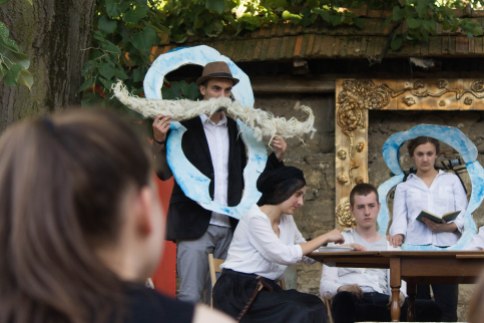This article was published by Civic Ideas. View more photos of the Most Mira program.
BANJA LUKA, BOSNIA-HERZEGOVINA—A carnival atmosphere dominated Banja Luka’s BASOC Center. Two dozen teens from the northwest Bosnian town of Prijedor buzzed around the courtyard, laughing and singing along with the ex-Yugo rock pouring out of speakers and over the old stone walls.

Mejra, an 18-year-old student, bit carefully into a local meat pastry, called burek, so as not to smudge her drawn-on moustache, and then set to work reassembling set pieces alongside the others: an Instagram border, an enormous gold picture frame, signs that read “the war came” and “the war passed – thank god.” The students were preparing for the final performance of their original play in the summer of 2017 as part of the Most Mira program, which translates to “Bridge of Peace.”
Their performance was part of a multi-year program that last performed in December 2018, designed to bring young Bosnians together to face the divides—generational, ethnic, gender—that have persisted in their society since the end of the conflict that tore Yugoslavia into seven countries.
In the summer of 1992, as the Bosnian war was beginning, Prijedor and the surrounding villages were under the control of Bosnian Serbs in the newly declared Republika Srpska. Over several months, an estimated 50,000 Bosniaks—Bosnian Muslims—were expelled from their homes. An additional 25,000 people (women, children and elders among them) were taken to the concentration camps of Omarska, Karaterm and Trnopolje outside of town. Most Mira founder and program director Kemal Pervanić was one of them. There, many were tortured or raped, and more than 3,000 were killed in a massacre unmatched in scale until Srebrenica in 1995. Today, Prijedor has the highest percentage of returnees of any town in Bosnia, and issues of memory and identity remain at the fore.
